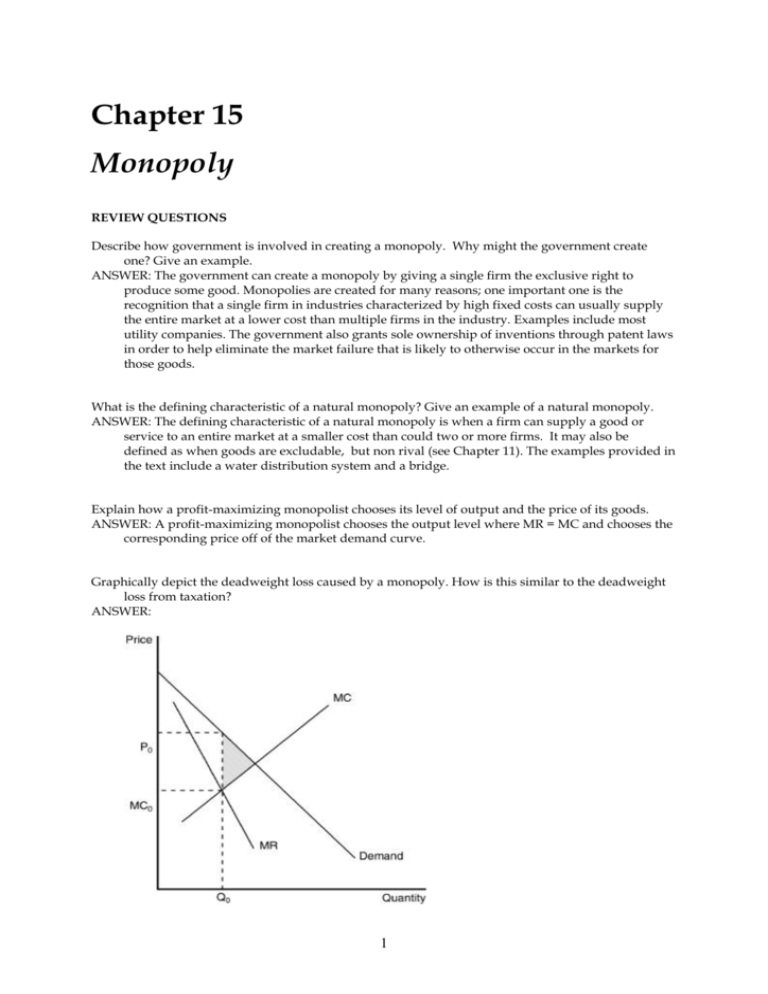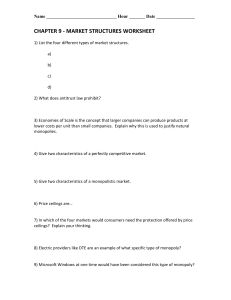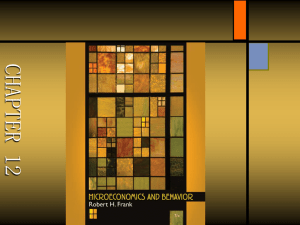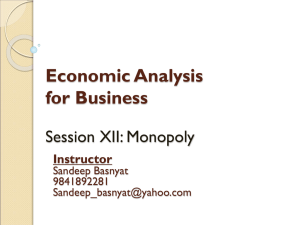Chapter 15 Monopoly
advertisement

Chapter 15 Monopoly REVIEW QUESTIONS Describe how government is involved in creating a monopoly. Why might the government create one? Give an example. ANSWER: The government can create a monopoly by giving a single firm the exclusive right to produce some good. Monopolies are created for many reasons; one important one is the recognition that a single firm in industries characterized by high fixed costs can usually supply the entire market at a lower cost than multiple firms in the industry. Examples include most utility companies. The government also grants sole ownership of inventions through patent laws in order to help eliminate the market failure that is likely to otherwise occur in the markets for those goods. What is the defining characteristic of a natural monopoly? Give an example of a natural monopoly. ANSWER: The defining characteristic of a natural monopoly is when a firm can supply a good or service to an entire market at a smaller cost than could two or more firms. It may also be defined as when goods are excludable, but non rival (see Chapter 11). The examples provided in the text include a water distribution system and a bridge. Explain how a profit-maximizing monopolist chooses its level of output and the price of its goods. ANSWER: A profit-maximizing monopolist chooses the output level where MR = MC and chooses the corresponding price off of the market demand curve. Graphically depict the deadweight loss caused by a monopoly. How is this similar to the deadweight loss from taxation? ANSWER: 1 A profit-maximizing monopolist will choose to produce Q0 units of output and sell at price P0. However, marginal cost is MC0. This is identical to the deadweight loss of taxation when the tax forces a wedge between market price and marginal cost. What is the deadweight loss due to profit-maximizing monopoly pricing under the following conditions: The price charged for goods produced is $10. The intersection of the marginal revenue and marginal cost curves occurs where output is 100 units and marginal revenue is $5. The socially efficient level of production is 110 units. The demand curve is linear and downward sloping and the marginal cost curve is linear and upward sloping. ANSWER: $25 Why might economists prefer private ownership of monopolies over public ownership of monopolies? ANSWER: The private monopolist is governed by the market. Even though the market solution is suboptimal, it may be better than outcomes generated by publicly owned monopolies. Publicly owned monopolies may restrict output to levels below the private market outcome and thus generate an even lower level of social surplus than a private profit maximizing monopolist. They also may not work to reduce costs. In the market for "home heating" consumers typically have several options (i.e., electricity, heating fuel, natural gas, propane, etc.) yet we often think of firms in this industry as behaving like monopolists. Using your understanding of monopoly, discuss the context in which your electricity provider is a monopolist. Is this characterization universally applicable? Carefully explain your answer. ANSWER: In this case, the firms are monopolists in the short run when consumers are unable to change their "home heating" systems. In the long run, consumers can change from electric appliances to natural gas appliances, and thus lessen the monopoly power of utility providers. As long as consumers are able to substitute, in the long run the monopoly power is reduced. In many countries, the government chooses to "internalize" the monopoly by owning monopoly providers of goods and services. (In some cases these firms are "nationalized" and the government actually buys or confiscates firms that operate in monopoly markets.) What would be the advantages and disadvantages of such an approach to ensuring the "best interest of society" is promoted in these markets? Carefully explain your answer. ANSWER: As long as the government "owner" pursues a production and pricing policy that approaches a competitive outcome, social well-being can be enhanced. In this case the government ownership would benefit society. However, in most cases, government owners operate much like private sector monopolists. The political economy of government institutions does not ensure that government owners will pursue socially optimal policy. There has been much discussion of deregulating electricity and natural gas delivery companies in the United States. Using your understanding of monopolies, discuss the likely effect of deregulation on prices in these two industries. Graphically depict these markets to help argue your point. ANSWER: If deregulation leads to increased competition then production and prices should move toward the competitive equilibrium. If deregulation does not lead to increased competition then the monopoly production and price outcome is likely. The success of deregulation movements hinges on their ability to use markets to promote competitive market outcomes. 2 Let's assume that a monopolist decides to maximize revenue, rather than profit. How does this operating objective change the size of the deadweight loss? If you are a "benevolent" manager of a monopoly firm and are interested in reducing the deadweight loss of monopoly, should you maximize profits or maximize revenue? Carefully explain your answer. ANSWER: A revenue maximizer operates where MR = 0. This solution moves the monopolist closer to the socially optimal competitive outcome, and reduces deadweight loss. Revenue maximization is potentially a more "socially" optimal objective for monopoly markets than profit maximization. One solution to the problems of marginal-cost pricing of a regulated monopolist is average-cost pricing. In this model, the monopolist is allowed to price its production at average total cost. How does average-cost pricing differ from marginal-cost pricing. Does this solution maximize social well-being? ANSWER: Average cost pricing always guarantees that the monopolist earns zero economic profits, but does not ensure a socially optimal market solution. What are the four ways that government policymakers can respond to the problem of monopoly? Briefly describe each. ANSWER: Trying to make monopolized industries more competitive. Regulating the behavior of monopolies. Turning some private monopolies into public enterprises. Do nothing. Explain the benefits and costs of antitrust laws. ANSWER: Benefits: Promote competition by preventing mergers and breaking-up companies. Costs: May increase cost of operating by restricting synergy mergers. Why do economists usually prefer private ownership to public ownership of natural monopolies? ANSWER: Private owners have an incentive to minimize cost as long as they reap part of the benefit in the form of higher profit. By contrast, government bureaucrats have no incentive to reduce costs and the losers are customers and taxpayers, whose only recourse is the political system. One example of price discrimination occurs in the publishing industry when a publisher initially releases an expensive hardcover edition of a popular novel, and later releases a cheaper paperback edition. Use this example to demonstrate the benefits and potential pitfalls of a price discrimination pricing strategy. ANSWER: The answer should address the three basic lessons of price discrimination. First, price discrimination is a rational strategy that can lead to higher monopoly profits. Second, price discrimination requires an ability to separate customers according to their willingness to pay. Third, price discrimination can raise economic welfare. 3








